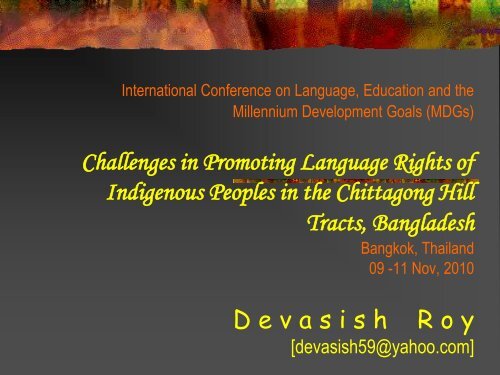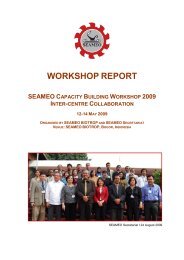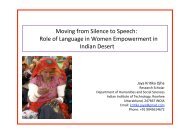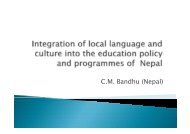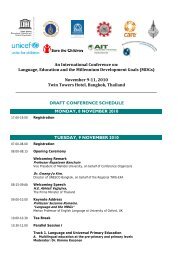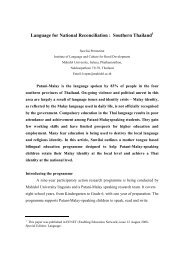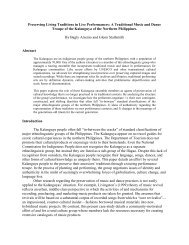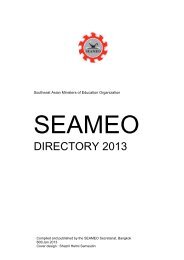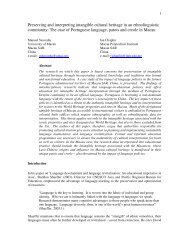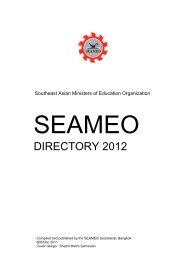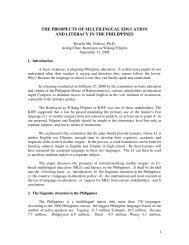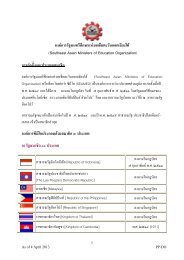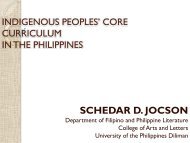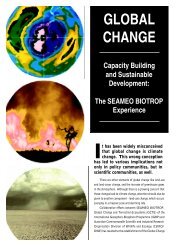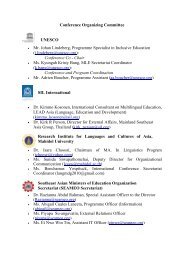indigenous peoples
indigenous peoples
indigenous peoples
You also want an ePaper? Increase the reach of your titles
YUMPU automatically turns print PDFs into web optimized ePapers that Google loves.
International Conference on Language, Education and the<br />
Millennium Development Goals (MDGs)<br />
Challenges in Promoting Language Rights of<br />
Indigenous Peoples in the Chittagong Hill<br />
Tracts, Bangladesh<br />
Bangkok, Thailand<br />
09 -11 Nov, 2010<br />
D e v a s i s h<br />
R o y<br />
[devasish59@yahoo.com]
location of bangladesh &<br />
chittagong hill tracts
zero.<br />
o v e r v i e w<br />
• PROFILE of CHT<br />
• The STATUS of Language Rights in CHT<br />
• INTERNATIONAL INSTRUMENTS & Language<br />
Rights<br />
• NATIONAL LAW & POLICY and Language Rights<br />
• Challenges in IMPLEMENTING Language Rights of<br />
Indigenous Peoples in CHT
PHOTO:<br />
Subrata Chakma<br />
one. profile of<br />
chittagong hill tracts
one.<br />
profile of chittagong hill tracts<br />
C O N S T I T U T I O N A L &<br />
A D M I N I S T R A T I V E B A C K G R O U N D<br />
• INDIGENOUS PEOPLES (ethno-linguistic minorities, some<br />
with own scripts)<br />
• BRITISH TRIBUTARY (1785), ANNEXATION (1860) (Tribal<br />
Area & Special Area)<br />
• EROSION OF AUTONOMY, UNREST & CHT (“peace’)<br />
ACCORD of 1997<br />
• Post-1997: PARTIALLY AUTONOMOUS SYSTEM with<br />
(limited) Authority over Primary Education, Land, Health,<br />
Agriculture, etc (Traditional, Elective & Bureaucratic Institutions)
• ENVIRONMENTAL DEGRADATION (affecting ACCESS TO<br />
WATER, livelihood security)<br />
one.<br />
profile of chittagong hill tracts CONT’D<br />
M D Gs : A C H A L L E N G E<br />
• Remote Areas Under-Served by State-Supported<br />
EDUCATION (community & NGO-run schools fill some gaps)<br />
• POVERTY & HUNGER widespread (worse among certain<br />
<strong>indigenous</strong> groups )<br />
• INFANT & MOTHER MORTALITY among the highest in<br />
country (POOR ACCESS to WATER, HEALTHCARE)<br />
• GENDERED PERSONAL LAWS & INADEQUATE<br />
REPRESENTATION OF WOMEN in Politics &<br />
Development
two. education rights status of chittagong<br />
hill tracts<br />
•
two. education rights status of chittagong hill tracts<br />
(Couqtesy: Mathuqa<br />
ipuqa)<br />
• Below National Average LITERACY RATE<br />
(1991 Census; significantly lower for several<br />
<strong>indigenous</strong> <strong>peoples</strong>; Demands for ethnically<br />
disaggregated data in Next Census)<br />
• 56.8% children aged 6 -10 years ENROLLED<br />
(less girls than boys; ADB Report, 2001)
two. education rights status of<br />
chittagong hill tracts (Couqtesy: Mathuqa<br />
Tqipuqa) CT<br />
• Only 60% COVERAGE BY NATIONAL<br />
EDUCATION SYSTEM (ADB Report, 2001)<br />
• 60% DROP OUT in primary education cycle<br />
(Double of national average; ADB, 2001: Language<br />
barrier identified as one of the prime causes of Drop<br />
Out of Indigenous Children)<br />
• Language of Education BENGALI (Curriculum<br />
does not reflect local culture, values and language)
three.<br />
language rights under international<br />
instruments
three.<br />
language rights under international<br />
instruments<br />
• ILO Convention on Indigenous & Tribal<br />
Peoples/Populations (Conventions 169, 107)<br />
• Convention on the Rights of the Child (CRC)<br />
• International Covenants on Civil & Political Rights &<br />
Economic, Social & Cultural Rights (ICCPR & ICESCR)<br />
• International Convention on the Elimination of All Forms<br />
of Racial Discrimination (CERD)<br />
• CEDAW<br />
• UN Declaration on the Rights of Indigenous Peoples<br />
(UNDRIP)
three. language rights .. international instruments CONT’’D<br />
ILO CONVENTION 107 (INDIGENOUS & TRIBAL<br />
POPULATIONS, 1957; ARTICLE 23)<br />
• “Children belonging to the populations<br />
concerned shall be taught to read and write in<br />
their mother tongue or, where this is not<br />
practicable, in the language most commonly<br />
used by the group to which they belong”
three. language rights .. international instruments CONT’’D<br />
UN DECLARATION ON THE RIGHTS OF INDIGENOUS<br />
PEOPLES (ARTICLE 14)<br />
1) “Indigenous <strong>peoples</strong> have the right to establish<br />
and control their educational systems and<br />
institutions providing education in their own<br />
languages, in a manner appropriate to their<br />
cultural methods of teaching and learning.”<br />
(2) “Indigenous individuals, particularly children,<br />
have the right to all levels and forms of education<br />
of the State without discrimination.”
three. language rights .. international instruments CONT’’D<br />
U ERMAET FRUM <br />
IIGEUS ISSUES: 4 TH SESSI<br />
(2005)<br />
• “Indigenous people have the right to quality primary<br />
education that is sensitive to their holistic worldviews,<br />
languages, traditional knowledge and other aspects of<br />
their cultures, which contribute to human dignity and<br />
intercultural dialogue”<br />
• “Mother-tongue mediated bilingual education is<br />
indispensable for effective learning for <strong>indigenous</strong><br />
children and for the reduction of drop-out rates..”
four.<br />
language rights under<br />
national instruments<br />
•<br />
Photo:<br />
Subrata Chakma
four.<br />
language rights under national<br />
instruments<br />
• LANGUAGE MARTYRS’ DAY (21 FEB)<br />
recognized by UNESCO as INTERNATIONAL<br />
MOTHER LANGUAGE DAY<br />
b a n g l a d e s h<br />
• INDEPENDEBNCE MOVEMENT (1971)<br />
drew upon LANGUAGE MOVEMENT<br />
(1952)
four.<br />
language rights under national<br />
instruments CONT’D<br />
• CONSTITUTIONAL PROVISIONS (on Non-<br />
Discrimination & Free & Compulsory Education:<br />
but Indigenous Peoples not directly<br />
RECOGNIZED)<br />
• COMPULSORY PRIMARY EDUCATION<br />
ACT, 1990, HILL DISTRICT COUNCILS<br />
ACT, 1989<br />
• CHT (“PEACE”) ACCORD, 1997
four. language rights under national instruments<br />
CONT’D<br />
• PRSP (“Education For All” & “Special Measures for<br />
Indigenous Children”)<br />
• NATIONAL EDUCATION POLICY, 2010<br />
• Establishment of Schools<br />
• Employment of Teachers<br />
• Indigenous Languages<br />
• Curriculum & Boarding Facilities
four. language rights under national instruments CONT’D<br />
RECOMMENDATIONS OF PEDP-II STRATEGY PAPER<br />
• RECRUIT community based teachers<br />
• ORGANIZE training and orientation courses for teachers<br />
• INTRODUCE pre-primary schooling with language<br />
education<br />
• REVIEW CURRICULUM and textbooks (in consultation with<br />
<strong>indigenous</strong> experts)<br />
• ESTABLISH new primary schools<br />
• Allow FLEXIBILITY (adjust school calendar according to local<br />
traditions, religion, and work. Allow for use of supplementary reading<br />
materials in local languages and encourage use of local materials as<br />
teaching aids)
five.<br />
c h a l l e n g e s
five.<br />
c h a l l e n g e s<br />
G O V E R N M E N T<br />
• Realizing the POSITIVE ASPECTS of MTB-MLE (e.g.,<br />
development, stability integration w/o assimmilation)<br />
• MAINSTREAMING Indigenous Rights Issues (e.g.,<br />
revising other sectoral policies & guidelines)<br />
• CAPACITY-RAISING to Coordinating the DIFFERENT<br />
ACTORS (Govt Departments, NGOs & Private Sector)<br />
• Providing Multilingual Education in MIXED<br />
SETTLEMENTS (curricula, teaching staff, etc)<br />
• DEVOLUTION (e.g., Hill District Councils, CHT)
five.<br />
c h a l l e n g e s CONT’d<br />
D O N O R & L E N D I N G A G E N C I E S<br />
• Implementing INDIGENOUS PEOPLES’ POLICIES (in<br />
Partnership with Indigenous Peoples, Governments & NGOs)<br />
• Funding CAPACITY-RAISING (Govt Departments, NGOs<br />
& Private Sector)<br />
• Streamlining PARIS PRINCIPLES to fit Indigenous<br />
Peoples’ Education & Development Rights Needs<br />
• Funding Indigenous Rights & Multilingual Education<br />
through APPROPRIATE FOCUS (e.g., Supporting<br />
Indigenous & Indigenous Issues-Informed Projects)
five.<br />
c h a l l e n g e s CONT’d<br />
U N A G E N C I E S<br />
• CAPACITY-RAISING (Mainstreaming Indigenous Issues)<br />
• Orientating Interventions around UN POLICIES on<br />
Indigenous Peoples’ Rights (UN Declaration on the Rights of<br />
Indigenous Peoples, UNDG Guidelines, Resolutions of UNDPFii,<br />
EMRIP & UN SRIP)<br />
• PROMOTION of Language Issues & IP Rights (Collective<br />
Rights of Indigenous Peoples & Individual Rights of<br />
Indigenous Children, Women, Men)
five.<br />
c h a l l e n g e s CONT’D<br />
N G Os<br />
• ACCESSING FUNDS (e.g., Paris Principles’ Negative Impact<br />
on Small NGOs)<br />
• INCLUDING Indigenous Peoples at All Stages of the<br />
Project Cycle (Consultation, Participation & FPIC)<br />
• Ending DISCRIMINATION by Governmental Agencies<br />
(Incorporation, Foreign Funding clearance & Confusion with<br />
Micro-Credit Activities)
five.<br />
c h a l l e n g e s CONT’D<br />
I N D I G E N O U S<br />
P E O P L E S<br />
• Promoting Indigenous Peoples’ SELF-GOVERNMENT &<br />
PARTICIPATORY RIGHTS (e.g., Implementing International<br />
& National Standards & CHT Accord Provisions)<br />
• De-Constructing MYTHS & MISINFORMATION {Asserting<br />
Equal Education Rights & Promoting Multilingual Education (inc<br />
De-Mystification of Equal Rights, CHT Accord &<br />
Multilingualism)}<br />
• Forging ALLIANCES (with Govt, UN Agencies, NGOs & Civil<br />
Society)
five.<br />
c h a l l e n g e s CONT’D<br />
P R I V A T E<br />
S E C T O R<br />
• Supporting Multilingual Education with FPIC<br />
of Indigenous Peoples<br />
• Equitable Filling of Gaps left by Governmental,<br />
Non-Governmental & Other Non-Private Sectors
five.<br />
c h a l l e n g e s CONT’D<br />
T H E M A J O R A C T O R S<br />
DONORS &<br />
LENDERS<br />
NATIONAL<br />
GOVERNMENT<br />
INDIGENOUS<br />
PEOPLES<br />
REGIONAL<br />
AUTHORITIES<br />
NGOS<br />
PRIVATE SECTOR
five.<br />
c h a l l e n g e s CONT’D<br />
T H E M A J O R C H A L L E N G E S<br />
CAPACITY<br />
Raising<br />
CONSTRUCTING<br />
Myths &<br />
Misinformation<br />
DE-MYSTIFYING<br />
Mother<br />
Tongue-Based<br />
Multilingual<br />
Education<br />
LANGUAGE<br />
& EDUCATION<br />
RIGHTS<br />
ORGANIZATIONAL<br />
STRENGTHENING of<br />
Indigenous Peoples’<br />
Organizations<br />
PROMOTING &<br />
IMPLEMENTING<br />
Indigenous Peoples’<br />
Rights<br />
FUNDING PRSPs &<br />
Other Policies<br />
Re-Orienting<br />
PARIS PRINCIPLES<br />
on Funding
Thank you<br />
Rally on International<br />
Mother Language<br />
Day:<br />
21 February, 2006<br />
Photo: Devasish Wangza


